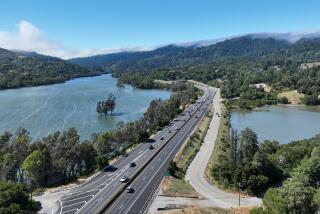ENVIRONMENT : Road Project Collides With Wetlands Plan : S. Carolina river basin rich in wildlife is threatened by proposed widening of route.
- Share via
WILLTOWN, S.C. — Here on the southern tip of South Carolina, amid moss-draped live oaks and sodden marshes, conservationists have worked for four years to protect 350,000 acres of pristine riverfront property that is home to ducks, storks, bald eagles, sea turtles and other wild creatures.
But now they fear their efforts may be harmed if the state Department of Highways and Public Transportation goes ahead with plans to widen a two-lane road to four lanes.
“If you had to pick the worst place in the state to build a highway, it would be here,” said Dana Beach, executive director of the South Carolina Coastal Council, a private nonprofit environmental group in Charleston.
As proposed, the widening of U.S. 17 here would require filling in 114 acres of wetlands, and would make the heavily traveled coastal route four lanes wide all across the state. To the north, the road feeds the popular golf resort of Myrtle Beach and to the south it winds near heavily developed Hilton Head Island.
But here, only a smattering of small, run-down homes and the grand manors of former rice plantations invade the countryside. Slightly smaller than Sequoia National Park, the ACE Basin--the common name for the watershed of the Ashepoo, Combahee and Edisto rivers--is as pristine an area as exists on the East Coast.
Since 1988, a coalition of individuals and agencies, including state and federal wildlife agencies, Ducks Unlimited and the Nature Conservancy, has tried to ensure that it stays that way.
Some lands within the area are owned by the state and federal governments, but the chief goal is to encourage private owners to protect the land by agreeing to permanent restrictions on developing it. So far, 55,400 acres have been protected by conservation easements, which prohibit development forever, while giving the property owner a tax deduction for the amount of the property’s decrease in value.
The owners of another 28,700 acres probably will act to restrict development in the coming months, said Charles Lane, the president of the coalition.
Lane, a 38-year-old real estate broker, has lived all his life here at Willtown, a 1,000-acre tract that was once a rice plantation worked by slaves.
“Willtown is 32 miles from downtown Charleston, has deep water access and a large bluff,” Lane said. “Somebody could easily lay out a harbor and golf course development--developed but destroyed.”
The ACE Basin has remained undeveloped because most of the land has been in the hands of wealthy industrialists like Gaylord Donnelley of Chicago, whose family owned R.R. Donnelley, one of the largest printing companies in the world. Those 80 or so families used the plantations primarily as hunting preserves after the waning of the South Carolina rice industry.
Today the former rice fields are a natural habitat for 14% of the dabbling ducks in the Atlantic flyway. The ACE Basin contains 17 wading bird rookeries and provides homes to three nesting colonies of the endangered wood stork and 24 pairs of bald eagles. Loggerhead sea turtles, also endangered, and alligators are frequently seen in the area.
All of this would be sabotaged if the highway is built, said Beach. He believes through-traffic should be encouraged to take the inland Interstate 95 route, while U.S. 17 should be turned into a scenic parkway.
But Brantley Harvey, a highway commissioner from Beaufort, just south of the ACE Basin, said U.S. 17 must be widened because it is already congested.
Harvey acknowledged that the wetlands will be harmed by the construction, but said the highway department will be required to improve wetlands in another area in exchange. He hopes construction can begin by 1994.
But Beach said: “This is a prescription for a fight. The highway department is doing its best to destroy anything that is characteristic of this place.”
Road to Ruin?
Plans to widen U.S. 17 may threaten 350,000 acres of pristine riverfront property known as the ACE Basin.
More to Read
Sign up for Essential California
The most important California stories and recommendations in your inbox every morning.
You may occasionally receive promotional content from the Los Angeles Times.













